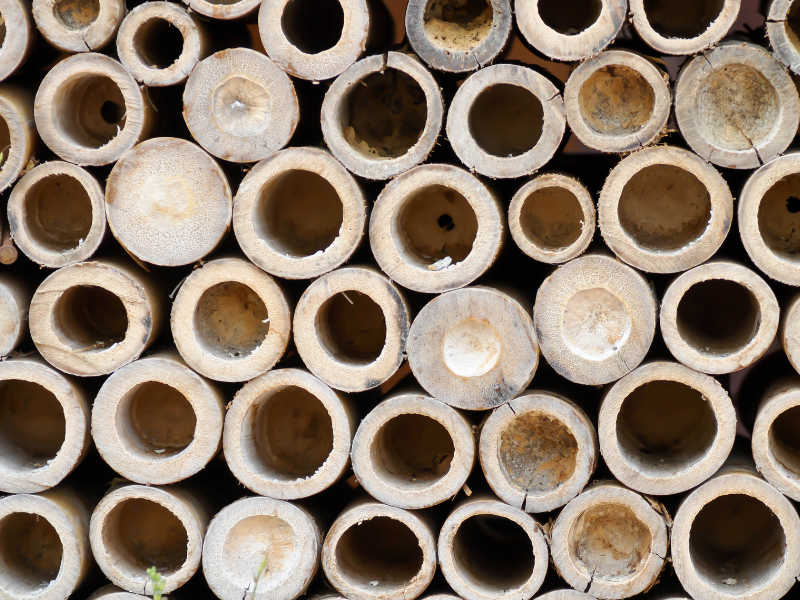Is Bamboo A Good Fabric For Clothing? Is Bamboo Good For Activewear?
Sustainability is top of mind for consumers and clothing brands alike these days. Customers increasingly take the time to look at clothing labels to understand what they are about to put on their bodies. But consumers won't compromise quality in place of sustainability - so with the rising popularity of eco-materials like bamboo, consumers want to know if bamboo is as high quality as it is eco-friendly.
Garments made from bamboo fibers are both high-quality and eco-friendly. Bamboo fabrics are naturally soft, durable, and thermal regulating in both warm and cold weather. Bamboo fabric is ideal for activewear since it is highly absorbent and has antimicrobial properties, combatting moisture and odor.
For many of these reasons, athletic, athleisure, and even outdoor brands are using bamboo to create functional fitness clothing. Numerous brands in the activewear space are using bamboo fabric to break out, finding that blend of eco-friendliness and performance that consumers are chasing.
The variety of clothing that can be made from bamboo is staggering, and if you're in the process of investigating bamboo for your next activewear line, the following are questions you should be asking, because your customers will ask them.
9 of The Most Asked Questions of Bamboo Activewear
1. Is Bamboo Clothing Good for Sweating?
Bamboo is an excellent material to use in clothing that will see lots of sweat and moisture. Sports bras, yoga pants, or active tees - you name it, bamboo clothing is great for sweaty situations for a handful of reasons that work together to keep you cool, dry and odor-free.
This is directly a result of its moisture-wicking properties.
2. Is Bamboo Clothing Moisture Wicking?
Bamboo holds strong moisture-wicking properties because it is a hollow fiber. This means that the fabric can absorb three times its weight in water before feeling wet. The fabric pulls the moisture (sweat) away from your skin and allows it to evaporate quickly, keeping you cool and dry.
The bamboo plant is naturally good at soaking up water when it grows - not only does this explain some of its sustainability benefits but it also explains why it’s great for activewear.
When you sweat in bamboo clothing, the fibers will absorb the moisture off your skin and trap it in the material on your exterior. Then the sweat has a chance to evaporate into the air and will help you stay dry, naturally wicking away your sweat.
3. Is Bamboo Clothing Antimicrobial?
Bamboo has natural antimicrobial properties, from a bio-agent called "bamboo Kun" that prevents bacteria from growing. This means that your bamboo clothing will not only feel dryer, but will also smell fresher for longer.
The bamboo plant's Kun helps to ward off pests and diseases so it can continue to grow. Kun is a natural bacteriostatic agent only found in bamboo, which helps prevent the growth of bacteria. Fiber made out of bamboo benefits from the antibacterial properties of the plant itself. Even when bamboo fibers are converted from the raw material into the fabric, the antimicrobial properties remain intact.
Everyone knows the unpleasant odor that sweaty clothes give off. Bamboo makes great clothing for sweat because it helps fight the bacteria that are creating sweaty odors. The natural antimicrobial properties of the material will not just keep you healthier but also smelling much fresher!
4. Is Bamboo Clothing Breathable?
Bamboo is a highly breathable fabric, making it ideal for athletes or activewear and athletic apparel. The hollow structure of bamboo fibers allows air to circulate more freely through the fabric, which helps to regulate body temperature by wicking away moisture and keeping you cool.
The way bamboo fibers are constructed also allows your skin to breathe more easily. When you wear bamboo clothing, the fabric will actually help to regulate your body temperature by wicking away moisture and keeping you cool.
5. Is Bamboo Clothing Durable?
Bamboo is a strong and durable material, making it ideal for activewear that will see a lot of wear and tear. The fibers are twice as strong as cotton, making them less likely to rip or tear.
The tensile strength of bamboo fibers is higher than many common textile fibers like cotton or linen.
Bamboo is a thick and fibrous plant that is incredibly resilient in the wild and grows easily in many settings. The fibers created from the bamboo plant that later go into clothing are long and tough, which makes them resistant to wear.
The process to create bamboo fabric also infuses a lot of strength into the final product. Similar to processed hemp, bamboo rayon has incredible tensile strength when compared to other fabrics or even materials like steel. Bamboo fabric can be stretched and twisted without breaking or losing shape.
The fibers of the bamboo plant are also much longer and smoother than cotton which creates clothing that is resistant to fraying. The smooth and silky feel of bamboo clothing makes it difficult to catch on edges and tear. The material is also resistant to pilling and bunching up.
The best part about bamboo clothing is that it will last you a long time and is easy to care for. Bamboo clothing outperforms the longevity of many other material options.
6. Is Bamboo Comfortable?
Bamboo is an incredibly soft material, both comfortable next to your skin and as outerwear. Bamboo is hypoallergenic, an ideal option for people with sensitive skin and allergies. Additionally, bamboo fabric is resistant to dust mites and mold, adding comfort to people with respiratory conditions.
One of the best things about clothing made from bamboo is the level of comfort it provides. Bamboo is recognized for creating clothing that is very soft and smooth to the touch. Many people who wear bamboo garments describe the feeling as silky.
One reason bamboo garments feel so soft and gentle on the skin is because of how it's woven -the threads lie flat and straight, preventing irritation and abrasion to the skin like some other materials.
Since bamboo fibers are smoother and longer than other natural fibers, such as cotton, it gives bamboo fabrics a stretchier feel.
In fact, the elastic nature of the bamboo fabric is one of the biggest reasons it makes for such a great activewear material. Athletic brands, and their customers, love bamboo-based fabrics because of their stretch and resiliency.
7. Is Bamboo Fabric Eco-Friendly?
Responsibly harvested bamboo is generally considered one of the more environmentally friendly fibers. However, the eco-friendliness of bamboo fabric is mostly determined by how it's processed, if it's bamboo viscose, this is less sustainable, as it's hazardous to water systems.
On the other hand, bamboo lyocell and mechanically manufactured bamboo fabrics are far more eco-friendly than bamboo viscose.
Chemical manufacturing that's used to create bamboo viscose is the quickest way to break the fibers down to form a thread, but it can release pollution into the waterways, whereas mechanical manufacturing uses no chemicals but is far more intensive with labor.
Somewhere in between is bamboo lyocell, which is a solvent-based chemical manufacturing process that uses a closed-loop system, maintaining around 99% of the mix for reuse, and is priced between viscose bamboo and me.
To learn more about bamboo viscose, bamboo lyocell, and mechanically processed bamboo, check out the Sport Casuals' article "Is Bamboo Clothing Truly Sustainable? Yes and No".
8. Is Bamboo Fabric Expensive?
Because bamboo is regenerative and fast-growing, forms of it are far less expensive than fabrics like organic cotton. This applies largely to chemically manufactured bamboo fabrics via viscose; which is affordable but can be harmful to the environment.
Bamboo lyocell and mechanically manufactured bamboo, like bamboo linen blends, are more expensive than organic cotton, yet offer a more eco-friendly solution for textile production.
9. What is Bamboo Charcoal in Clothing?
Bamboo charcoal is a type of bamboo fabric that is made by processing powdered char of bamboo, biochar as it's called, and then weaving the charcoal into the fabric. Bamboo Charcoal is said to have several benefits, including antimicrobial, adsorbent, and odor-resistance.
Bamboo charcoal is often used in activewear and underwear because of its ability to wick away sweat and moisture. Plus it's rated for sun protection (UPF 50+), meaning it will protect your skin from harmful UV rays.
Bamboo Charcoal is one of the most trending eco-friendly fabrics in activewear, set to gain even more traction in the coming few years.
Bamboo Offers Form, Fashion, Function, and Friendliness
Bamboo clothing uniquely covers all sides of contemporary activewear: performance, comfort, style, and environmental chops. And the benefits of this miracle fiber are maintained even as it makes the transition to thread, fabric, and garment.
As a reminder, here are just a few of the performance benefits of bamboo clothing:
Moisture-wicking
Odor resistant
Antimicrobial
Breathable
Thermoregulating
Long-lasting
Resistant to tearing and fraying
Easy to care for
Activewear Consumers Crave Bamboo Fabrics
While still widely worn, even organic cotton is demanding on the environment. And synthetic fabrics like polyester are easily the most popular materials in textiles today, but they require harmful inputs and create toxic outputs that never disappear.
But, consumers want more. And the best clothing brands are stepping up to this demand by using more environmentally friendly materials and processes in their business. To create eco-friendly clothing, brands are incorporating different materials such as recycled fabrics and natural fibers like hemp or bamboo.
The bamboo plant is a wonderfully regenerative resource and can be used to create sustainable clothing. But even if consumers do want to wear more environmentally conscious materials, the basic demands remain: the clothing has to be fashionable, comfortable, and high quality.

